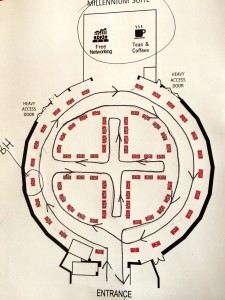This is the third part of a series of blogs about trade shows. Blog one and two are here. This installment is targeted at visitors.
I am a passionate supporter of trade shows, conferences and similar events, yet, this blog—as with every post in the series—does challenge organisers, exhibitors, visitors and the industry sectors surrounding them to make such get-togethers more effective.
Why are you here?
I wonder how many people walking the aisles of a trade show this week could answer that question. I mean properly answer it. There are many good reasons to attend a trade event, but ‘We come every year’ isn’t one of them.
If a show is local to one’s place of work there is no real harm in popping to peruse an exhibit or two. Who knows when a money-saving, value-adding, efficiency-creating solution might present itself? However, if travel and overnight stays are required, one should make sure the investment is going to be worth it. The best way to choose a show is to consider what would be the best case scenario having walked its miles of aisles and assess a particular event’s chances of delivering that outcome.
Trade show organisers are often criticised for not giving visitors ROI, which is sometimes fair, but not if the event upheld its commitment to a target audience only to be challenged unjustly on why it didn’t do something else for a sector it never really pretended to cater for. Often, supply chains have many different links from the product manufacturer or inventor of a service to its application in an end user market or by a consumer. One must be sure an event connects the links of that chain relevant to their business.
The four most common reasons I find people visit trade shows are:
-Build knowledge
-Network with old and new contacts
-Activity related to buying decisions
-Sell something themselves
I’ll come back to No. 4 when I’ve grabbed a big stick because it’s a particular bugbear of mine. Whether it is to build knowledge, network or prepare for an equipment or service purchase, plan ahead. Chances are, a visitor’s objective at a trade show will only be met by certain exhibitors. Exhibitor lists and stand plans are readily available so, if you’re planning a visit, highlight the ones most likely to provide a solution to problems and make a routemap.
If it is a small business show with only, say, 100 exhibitors, there is probably less requirement to earmark vendors in advance as one could walk the aisles in the space of a few hours, providing they remain efficient (more on that coming up). However, it’s still important to plan the best route to take around the aisles.
Weaving a web
Ahead of exhibiting at the South East Business Show at Copthorne Hotel, near Gatwick a year or so ago, I drew on the stand plan a map of how I would approach the aisles, and Tweeted it. This was just an exercise but it’s worth doing. Take the face of a clock, for example. One would want to visit the 12 exhibitors clockwise or anticlockwise. Visiting 1, then 7, then 2, then 8, then 3, would result in wasted walking time. A heat map of a visitor’s footfall shouldn’t look like a spider’s web.
When you’ve got a list of exhibitors that you’d like to meet, introduce yourself in advance of the event. There’s a chance a busy exhibitor won’t be able to keep to a specific appointment slot, but at least advise them of interest and tell them to expect you to call on their exhibit. Social media and event hashtags aren’t reserved for exhibitors. Too few visitors use Twitter, for example, to raise their profile and promote exhibitors they know or that could be of value in future.
To use the clock face floor plan again, it may be that your routemap only requires you to visit exhibitors 1, 2, 9 and 11. If that’s the case, don’t feel obliged to spend time with 3, 4, 5 and so on, unless you see something of particular interest in passing. Not only will it waste the visitor’s time but the exhibitors’ too. Many vendors will have someone responsible for getting traffic on their stand but politely refuse if the exhibit is irrelevant.
Cuckoo clock
Right, back to No. 4. It is very common for people to attend trade shows to promote their own company or sell products and services. There are some instances where this is fine. If a conversation with an exhibitor has reached the point where collaboration might be mutually beneficial or a vendor has asked out of interest, take the opportunity. However, as a rule, it should be forbidden.
It is infuriating when a company has spent valuable marketing budget on a trade show stand and graphics, only for a visitor who has paid nothing, to expect their staff’s time to sell a service. My company was still wet behind the ears when we spent what little cash we had on some postcards and a couple of pop-up banners. We were thrilled when a smartly dressed man enquired about our services, only to dump his bag on our table and proceed with a sales pitch about why we should be giving his company a referral fee to make introductions on our behalf. Nothing against his business model but there is a time and place. That wasn’t it.
Finally, I urge you to consider events with co-located conferences, seminars or other content. Good organisers will invite high-level presenters to deliver educational, informative content relevant to the industry sector or trade show audience. Good content is a hallmark of a well-run event. We have clients who look for such events to exhibit their products; such is their faith in content drawing a relevant, engaged audience. It’s good PR to be part of that.
Oh, and wear comfortable shoes!
I’d be interested to hear your trade show stories, especially if you’ve walked the aisles as a visitor recently.
My next blog is inspired by an old colleague, Packaging Pittman, and will guide exhibitors on quality media engagement on the show floor and in the press room.
Follow the business on Twitter @BridgerHowes
Richard Howes
Director, Bridger Howes Limited
rich@bridgerhowes.com


